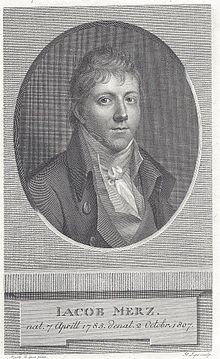Jacob Merz
Jacob Merz (born April 7, 1783 in Hirslanden , † October 2, 1807 in Vienna ) was a Swiss draftsman , painter and engraver .
Life
Jacob Merz was born on April 7, 1783 as the son of the weaver Christian Merz from the Swabian Tieringen and his wife Angelika Weber and grew up in Hirslanden in a former hunting lodge of Colonel Salomon Hirzel in Buch am Irchel . The pastor of Andelfingen, Johann Wilhelm Veith recognized Merz's talent for drawing. He took him into his house in 1795 and introduced him to Johann Caspar Lavater and Johann Heinrich Lips . Veith financed his apprenticeship as a copper engraver at Lips from 1797 to 1801. In 1802 Merz engraved a portrait of Lavater, with which he applied to the Vienna Academy .
In September 1802 Merz traveled to Vienna and was accepted at the academy under the care of Heinrich Friedrich Füger . In 1803 and 1804, through the mediation of Count Delmotte, he obtained financial contributions from Archduke Karl . Merz, who only turned to oil painting at the end of 1803, quickly gained recognition for his portraits and miniatures. In 1805 he undertook a trip to Slovakia and Hungary , supported by Princess Krasalcowiz . Back in Vienna in November 1805 he made a miniature portrait of Antonio Canova in black, white and red chalk , of which he engraved two versions.
In November 1805 he was forcibly conscripted into the army as a "rationalist" because of a denunciation by a fellow student . However, with the help of influential patrons, including the Princess von Schwarzenberg and his teacher Füger, he succeeded in being released after six days. He recorded the pattern scene in a drawing. In 1806 Merz was commissioned by the Viennese court to make an engraving of the equestrian monument to Emperor Joseph. II. To manufacture. He worked ten months on the large-format engraving, for which he received recognition and a reward of 1,000 guilders. At the end of September 1807 Merz fell ill with a septic disease after an excursion. He died on October 2, 1807 in Vienna.
Works
Most of the portraits, including self-portraits, have survived from Jacob Merz's short creative period. Several portfolios with around 300 drawings by Merzen were acquired between 1868 and 1870 by the wealthy Californian judge Edward Bryant Crocker on a trip to Germany and transferred to the city of Sacramento by his widow in 1885. The drawings have been scientifically processed since 1936 and are in the Crocker Art Museum in Sacramento . A selection was shown in 1981 in the Haus zum Rechberg in Zurich and in the Academy of Fine Arts Vienna . The three hundred works by Merz in Sacramento today represent practically the entire estate.
literature
- Keyword Merz (Jakob) in: General Artist Lexicon, or: Brief message about the life and works of painters, sculptors, builders, engravers, art founders, steel cutters .. , Volume 2, Part 4, by Johann Rudolf Fuessli, Hans Heinrich Füssli, Orell, Füssli & Company, Zurich 1809, p. 846. ( digitized version )
- Johann Wilhelm Veith: Notes from the life of Jakob Merz, Mahler and Kupferäzer . Tübingen 1810. ( digitized version )
- Constantin von Wurzbach : Maerz, Jacob . In: Biographisches Lexikon des Kaiserthums Oesterreich . 16th part. Kaiserlich-Königliche Hof- und Staatsdruckerei, Vienna 1867, p. 252 ( digitized version ).
- Constantin von Wurzbach : Merz, Jacob . In: Biographisches Lexikon des Kaiserthums Oesterreich . 17th part. Imperial and Royal Court and State Printing Office, Vienna 1867, pp. 419–421 ( digitized version ).
- Albert Ilg: Merz, Jacob . In: Allgemeine Deutsche Biographie (ADB). Volume 21, Duncker & Humblot, Leipzig 1885, p. 483 f.
- H. Keller: Jakob Merz, self-portrait. Kunstverein Winterthur, Annual Report LII, 1972, pp. 31–36.
- Seymour Howard: Jacob Merz 1783–1807 - Drawings from the Crocker Art Museum Sacramento, California. Exhibition catalog Haus zum Rechberg, Zurich, 1981.
Web links
- Tapan Bhattacharya: Merz, Jacob. In: Historical Lexicon of Switzerland .
- Hans A. Lüthy: Merz, Jakob (Jacob) (Raffael von Buch). In: Sikart (as of 1998)
Individual evidence
- ↑ Howard 1981, p. 44.
- ↑ Merzen's report in: Johann Wilhelm Veith, 1811, pp. 53–72.
- ↑ Howard 1981, p. 61.
- ↑ Howard 1981, pp. 19f.
- ↑ Howard 1981, p. 20.
- ↑ Howard 1981, p. 6.
| personal data | |
|---|---|
| SURNAME | Merz, Jacob |
| ALTERNATIVE NAMES | Merz, Jakob; March, Jakob; March, Jacob |
| BRIEF DESCRIPTION | Swiss draftsman, painter and engraver |
| DATE OF BIRTH | April 7, 1783 |
| PLACE OF BIRTH | Hirslanden |
| DATE OF DEATH | October 2, 1807 |
| Place of death | Vienna |
